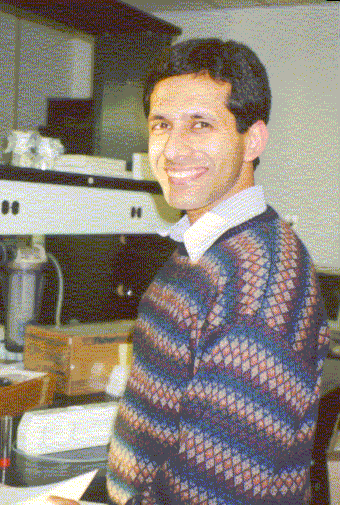
Bioengineering Laboratory
Department of Chemical Engineering
906 Furnas Hall
State University of New York at Buffalo
Buffalo, NY 14260-4200
Phone: (716) 645-2911 ext. 2220
Fax : (716) 645-3822
E-mail: neel@eng.buffalo.edu
 |
Sriram Neelamegham Bioengineering Laboratory Department of Chemical Engineering 906 Furnas Hall State University of New York at Buffalo Buffalo, NY 14260-4200 Phone: (716) 645-2911 ext. 2220 Fax : (716) 645-3822 E-mail: neel@eng.buffalo.edu |
Professor, State University of New York at Buffalo, 2008-present
Associate Professor, State University of New York at Buffalo,
2003-2008
Assistant Professor, State University of New York at Buffalo, 1997-2003
Research Associate, Baylor College
of Medicine, Houston, 1995- 1997.
Ph.D., Chemical/Biomedical Engineering, Rice
University, Houston, 1996.
B.Tech., Chemical Engineering, Indian Institute of Technology, Delhi,
India, 1991.
· Research Interests
· Publications
· Courses
· Supplemental
Data
Research Interests
My laboratory performs investigations in the fields of Molecular & Cellular Bioengineering, Systems Glycobiology, and Thrombosis & Hemostasis. In particular, we are interested in applying quantitative experimental and computational techniques to discover new mechanisms that control the cell adhesion properties of blood leukocytes and platelets during human inflammatory and thrombotic disorders. Many of the projects in my laboratory assess the roles of fluid/hydrodynamic forces, biochemical reaction networks and cell adhesion molecule binding properties on blood cell adhesion mechanics during inflammation, thrombosis & hemostasis, and cancer. A long term goal is to apply our knowledge of these regulatory pathways to identify new targets for drug development.
Our studies of inflammation biology examine the contribution of cell surface carbohydrate structures or glycans to white blood cell (leukocyte) activation and adhesion. In this regard, while glycosylation is a major post-translational modification (PTM) that alters the structure of most human proteins, relatively little is known about the functional diversity imparted by this modification. Unlike other PTMs like phosphorylation which are single step events, glycan biosynthesis is more complex since it involves the concerted action of a family of ~200 enzymes called glycosyltransferases (1% of the human genome). In my laboratory, we have developed numerous experimental tools to examine glycosylation at the molecular, cellular and animal levels. Principles of chemical reaction kinetics are used to model glycosylation reaction networks. The end goal is to apply systems level understanding of glycosylation processes in order to uncover new pathways and small molecule inhibitors that can control leukocyte migration during inflammation. This project also aims to develop cutting-edge experimental tools and theoretical concepts for studies in the emerging field of “Systems Glycobiology”.
Other studies in my laboratory focus on von Willebrand Factor (VWF) structure-function relationships. This study is clinically significant since the recruitment of blood platelets by immobilized VWF at sites of vascular injury is an important contributor to arterial occlusion during myocardial infarction (heart attack) and stroke. In particular, we are interested in understanding how fluid shear and surface immobilization alters the three-dimensional structure of VWF thus promoting both protein conformation change and VWF self-association. In this regard, the former alteration affects the affinity of platelet-VWF interaction. The latter affects the avidity of this molecular binding event. While hypotheses related to this project are typically generated using computational models and in vitro experiments, we typically also validate these hypotheses using animal models and human blood samples from normal and disease individuals.
Glycosylation Network Analysis Toolbox (GNAT): a MATLAB based environment for systems glycobiology. Liu, G. Puri, A., Neelamegham, S., Bioinformatics. 2012 [to appear]. (Download Toolbox)
Silencing α1,3-fucosyltransferases in human leukocytes reveals a role for FUT9 during E-selectin mediated cell adhesion. Buffone A, Mondal N, Gupta R, McHugh KP, Lau JT, Neelamegham S., J Biol Chem. 2012 Nov 28. [Epub ahead of print]
von Willebrand factor (VWF) propeptide binding to VWF D'D3 domain attenuates platelet activation and adhesion. Madabhushi SR, Shang C, Dayananda KM, Rittenhouse-Olson K, Murphy M, Ryan TE, Montgomery RR, Neelamegham S. Blood. 2012 May 17;119(20):4769-78.
Scaling down the size and increasing the throughput of glycosyltransferase assays: activity changes on stem cell differentiation. Patil SA, Chandrasekaran EV, Matta KL, Parikh A, Tzanakakis ES, Neelamegham S. Anal Biochem. 2012 Jun 15;425(2):135-44.
Characterization of cancer associated mucin type O-glycans using the exchange sialylation properties of mammalian sialyltransferase ST3Gal-II. Chandrasekaran EV, Xue J, Xia J, Locke RD, Patil SA, Neelamegham S, Matta KL. J Proteome Res. 2012 Apr 6;11(4):2609-18.
Understanding glycomechanics using mathematical modeling: a review of current approaches to simulate cellular glycosylation reaction networks. Puri A, Neelamegham S. Ann Biomed Eng. 2012 Apr;40(4):816-27.
Escherichia coli-derived von Willebrand factor-A2 domain fluorescence/Förster resonance energy transfer proteins that quantify ADAMTS13 activity. Dayananda KM, Gogia S, Neelamegham S. Anal Biochem. 2011 Mar 15;410(2):206-13.
Systems glycobiology: biochemical reaction networks regulating glycan structure and function. Neelamegham S, Liu G. Glycobiology. 2011 Dec;21(12):1541-53.
von Willebrand factor self-association on platelet GpIbalpha under hydrodynamic shear: effect on shear-induced platelet activation. Dayananda KM, Singh I, Mondal N, Neelamegham S. Blood. 2010 Nov 11;116(19):3990-8. Commentary on this article [LINK]
Fluorinated per-acetylated GalNAc metabolically alters glycan structures on leukocyte PSGL-1 and reduces cell binding to selectins. Marathe DD, Buffone A Jr, Chandrasekaran EV, Xue J, Locke RD, Nasirikenari M, Lau JT, Matta KL, Neelamegham S. Blood. 2010 Feb 11;115(6):1303-12. Commentary on this article [LINK]
Application of fluorescence spectroscopy to quantify shear-induced protein conformation change. Themistou E, Singh I, Shang C, Balu-Iyer SV, Alexandridis P, Neelamegham S. Biophys J. 2009 Nov 4;97(9):2567-76
Detection of site-specific glycosylation in proteins using flow cytometry. Jayakumar D, Marathe DD, Neelamegham S. Cytometry A. 2009 Oct;75(10):866-73.
Fluid shear induces conformation change in human blood protein von Willebrand factor in solution. Singh I, Themistou E, Porcar L, Neelamegham S. Biophys J. 2009 Mar 18;96(6):2313-20.
Courses Taught:
Biochemical Engineering, CE446/547
Bio Transport and Kinetics, CE500
Cell Biology-II, BMS505
Cell and Molecular Bioengineering, CE405/505
Transport Process II, CE318
Fluid Mechanics Laboratory, CE427
Heat and Mass Transfer Laboratory, CE428